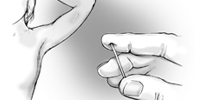Contraceptive implants work in a similar way to the Pill. The implant, a small thin flexible rod, contains a hormone that helps to prevent pregnancy.
The implant is 4cm long and made of plastic. It is inserted just under the skin on the inside of the arm. This must be done by a doctor or nurse who is familiar with the technique.
The implant steadily releases a small amount of hormone. This helps to prevents pregnancy for three years. The implant must be removed at the end of three years but it can be taken out at any time by a doctor or nurse familiar with the removal technique.

How does the implant work?
The implant prevents pregnancy by:
- stopping a woman's ovaries from making an egg each month
- thickening the mucus that women have in their cervix (entrance to the womb). This makes it hard for sperm to get through and fertilise an egg.
How effective is it?
The contraceptive implant is more than 99.8 per cent effective in preventing pregnancy. But, remember that no contraceptive is 100 per cent reliable; statistics show that 1 in 20 women may still get pregnant.
Advantages
- Effective contraception for three years.
- You don't have to remember to use contraception every day.
- Doesn't interfere with sexual intercourse.
- Low cost.
Disadvantages
- Women using implants have changes to their periods. Most women have less bleeding than before the implant, but some have more frequent or longer periods.
- Some women have side effects that may include headaches and acne.
What about fertility?
The contraceptive implant doesn't interfere with fertility once it's removed – periods usually return to normal within one month.
Can you see or feel the implant?
You can't see the implant – it's hidden under your skin.You can feel it beneath the skin if you touch the place on your arm where it is inserted.
Who might choose to use the contraceptive implant?
A woman who:
- wants effective, long lasting and reversible contraception
- is willing to accept changes to her menstrual cycle.
The implant may be especially suitable if you:
- have difficulty remembering to take birth control pills
- don't like other contraceptive methods or find them unreliable
- can't take the hormone oestrogen.
The implant is one of many different contraceptives. Talk to your health practitioner about the choices available and the one that suits you best.
Who may not be able to use the implant?
It may not be suitable if you:
- have severe liver disease
- have unusual vaginal bleeding
- take medication that makes the implant less effective
- have blood clots in your legs or lungs
- can't take the hormone progesterone.
How is the implant put in and taken out?
The implant is put in under a local anaesthetic. This takes about one minute. Removing the implant is also done under local anaesthetic, and with a small incision. This may leave a very small scar. The insertion and removal of the implant must be done by a doctor or nurse who is familiar with these techniques. After insertion, you should be able to feel but not see the implant. If you can't feel it, see your doctor. Use a back-up method of contraception until the doctor tells you the implant is still in place.
Will it hurt?
Using an implant doesn't hurt. There may be some bruising and tenderness after having it put in or removed. This may last for up to a week. Wearing a bandage over the arm for 24 hours helps reduce bruising and tenderness. The area may itch slightly for a few days. It's important to avoid rubbing the skin over the implant.
Where to get more information
- Your local doctor (GP)
- Women’s Welcome Centre (Victoria only)
Tel: (03) 8345 3037 or 1800 442 007 (rural callers)
Information about long acting reversible contraception (LARC), including contraceptive implants, is also available in Arabic, Chinese, Hindi, Spanish, Urdu and Vietnamese – see Related Health Topics below
Related information
- Sexual Health Victoria for more information on contraception
- Provide feedback about the information on this page
Related Health Topics
Disclaimer
The Women’s does not accept any liability to any person for the information or advice (or use of such information or advice) which is provided on the Website or incorporated into it by reference. The Women’s provide this information on the understanding that all persons accessing it take responsibility for assessing its relevance and accuracy. Women are encouraged to discuss their health needs with a health practitioner. If you have concerns about your health, you should seek advice from your health care provider or if you require urgent care you should go to the nearest Emergency Dept.